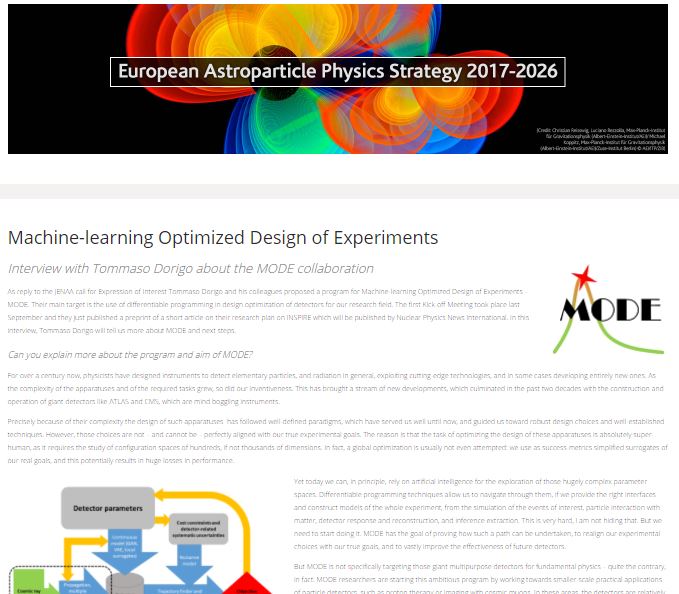The interview stems from the help that the JENAA group (a joint effort of APPEC, NuPECC and ECFA) is trying to offer to the research plan of the MODE collaboration, a group of physicists and computer scientists for which I am serving as the scientific coordinator.

The interview probably came out longer than Katrin had envisioned, but she gracefully accepted my utter incapability of being synthetic when I discuss these matters. Indeed, it is a couple of pages long, but it could have been ten times longer if I had not exercised some self-restraint. How much attention can you expect from even motivated, interesting readers these days? Well, if you are a regular visitor of this blog you are certainly a biased sample, as you must not be horrified to my typical slow convergence to the point under discussion in my posts.
So, I am thrilled to invite you to visit the APPEC web page and read all about MODE and its research program, but if your mouse has gotten stuck to the table overnight by spilt beer, or if you have a paralysis to your right arm, I will make it easier to you and summarize (ha ha) the matter for you here.
MODE is a collaboration of 20 physicists and computer scientists from eight institutes in Europe and the US (INFN, Université catholique de Louvain, Oxford University, Université Clermont Auvergne, Higher School of Economics of National Research University Moscow, New York University, and Université de Liege, without any regard to particular ordering).
Together, we have understood that we nowadays possess the software technology to target problems which were once wholly untreatable - so we have to put it to good use! And our focus is the design of experimental apparatuses which use the interaction of radiation with matter as the mechanism to extract information and perform measurements or inference.
The definition abobe is broad enough to include particle detectors for collider beams, astro-particle experiments flying on satellites, imaging instruments employing cosmic radiation to scan unknown volumes, proton therapy instruments, and industrial scanners used for quality control.
In all cases, the complexity of the particle detection mechanisms make it impossible for human beings to meaningful optimize the design of these instruments for their wanted final goal: what we have been doing, when designing instruments from simple PET scanners to complex LHC detectors, is to optimize some surrogates - such as a good energy or position resolution given cost constraints, or similar figures of merit which are not completely aligned to the true goals of those instruments. But today we can attack the problem of end-to-end optimization, and MODE is working on creating the software infrastructures that provide a solution to that.
Well, this summary is becoming already too long, but if you have more curiosity about our research program please visit the MODE Collaboration web page. There, among other descriptions, a list of references, and other material, you will find a link to a short article we published last month, where we describe our plan in a bit more detail. And thank you for your interest!
---
Tommaso Dorigo (see his personal web page here) is an experimental particle physicist who works for the INFN and the University of Padova, and collaborates with the CMS experiment at the CERN LHC. He coordinates the MODE Collaboration, a group of physicists and computer scientists from eight institutions in Europe and the US who aim to enable end-to-end optimization of detector design with differentiable programming. Dorigo is an editor of the journals Reviews in Physics and Physics Open. In 2016 Dorigo published the book "Anomaly! Collider Physics and the Quest for New Phenomena at Fermilab", an insider view of the sociology of big particle physics experiments. You can get a copy of the book on Amazon, or contact him to get a free pdf copy if you have limited financial means.






Comments